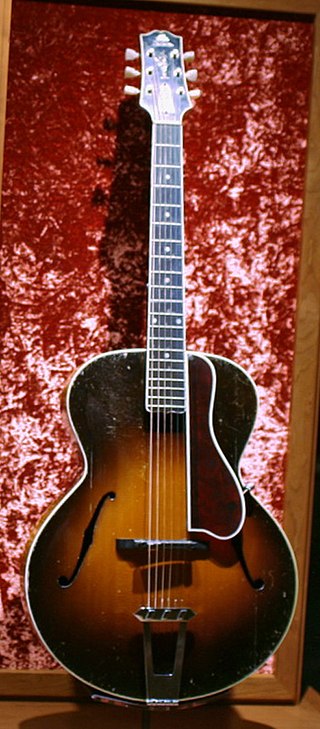
The Gibson L-5 is a hollow body guitar first produced in 1923 by the Gibson Guitar Corporation, then of Kalamazoo, Michigan. The first guitar to feature F-holes, the L-5 was designed under the direction of acoustical engineer and designer Lloyd Loar, and has been in production ever since. It was considered the premier guitar of the company during the big band era. It was originally offered as an acoustic instrument, with semi-acoustic models not made available until the 1940s.

The Gibson Les Paul is a solid body electric guitar that was first sold by the Gibson Guitar Corporation in 1952. The guitar was designed by factory manager John Huis and his team with input from and endorsement by guitarist Les Paul. Its typical design features a solid mahogany body with a carved maple top and a single cutaway, a mahogany set-in neck with a rosewood fretboard, two pickups with independent volume and tone controls, and a stoptail bridge, although variants exist.

Epiphone is an American musical instrument brand that traces its roots to a musical instrument manufacturing business founded in 1873 by Anastasios Stathopoulos in İzmir, Ottoman Empire, and moved to New York City in 1908. After taking over his father's business, Epaminondas Stathopoulos named the company "Epiphone" as a combination of his own nickname "Epi" and the suffix "-phone" in 1928, the same year it began making guitars. From the 1930s through to the early 1950s, Epiphone produced a range of both acoustic and (later) electrified archtop guitars that rivalled those produced by Gibson and were the instruments of choice of many professionals; a smaller range of flat-top guitars were also produced, some designations of which were later continued during the Gibson-owned era for the company.

The Gibson ES-335 is a semi-hollow body semi-acoustic guitar introduced by the Gibson Guitar Corporation as part of its ES series in 1958. It features a solid maple wood block running through the center of its body with upper bouts that are hollow and two violin-style f-holes cut into the top over the hollow chambers. Since its release, Gibson has released numerous variations of and other models based on the design of the ES-335.
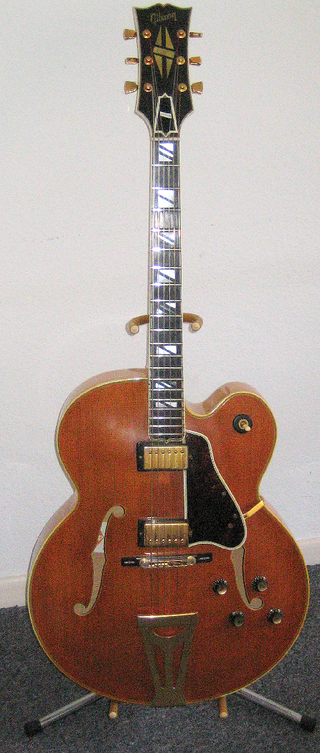
An archtop guitar is a hollow acoustic or semi-acoustic guitar with a full body and a distinctive arched top, whose sound is particularly popular with jazz, blues, and rockabilly players.
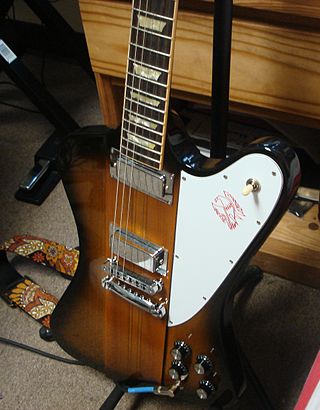
The Gibson Firebird is a solid-body electric guitar manufactured by Gibson beginning in 1963.

The Gibson Explorer is a type of electric guitar model by Gibson guitars, released in 1958. The Explorer offered a radical, "futuristic" body design, much like its siblings: the Flying V, which was released the same year, and the Moderne, which was designed in 1957 but not released until 1982. The Explorer was the final development of a prototype design that, years later, Gibson marketed under the name Futura.

The G-400 is an Epiphone solid body electric guitar model produced as a more modestly priced version of the famous Gibson SG. Currently, Epiphone is a subsidiary of Gibson and manufactures the G-400 and other budget models at a lower cost in Asia. Visually and ergonomically, it is almost identical to a 1962 SG.

The Gibson Hummingbird is an acoustic guitar model/series produced by the Gibson Guitar Corporation.

The Fender Coronado is a double-cutaway thin-line hollow-body electric guitar, announced in 1965. It is manufactured by Fender Musical Instruments Corporation. The aesthetic design embodied in the Coronado represents a departure from previous Fender instruments; the design remains an uncharacteristic piece of Fender history.

The Univox Hi-Flier is an electric guitar marketed and sold by Univox from roughly 1967 to 1980. With its reversed offset body, the Hi-Flier has an intentional resemblance to the Mosrite Ventures model. A bass version of the Hi-Flier was also available.
The Epiphone Sheraton is a thinline semi-hollow body electric guitar. Though the Sheraton and all its variations were introduced under the ownership of the Gibson Guitar Corporation, Epiphone is the exclusive manufacturer.

The Epiphone Joe Pass Emperor II is an electric guitar model produced by Epiphone in Korea as Joe Pass's signature model. First released in 1994, just prior to Joe Pass's death, and was produced until 2015.

Duesenberg is a brand for electric string instruments founded in 1986 and located in Hannover, Germany. The headquarter is in Hannover, Germany, they are known for using a Plek machine for the levelling of frets and setup. Duesenberg has uploaded a factory production video of how their guitars are made, revealing that most of the production of the guitars is done in Croatia, while the final setup and assembly is done in Germany.

The Gibson ES-333 is a semi hollow body electric guitar made by Gibson Guitar Corporation.

The Epiphone Dot is a semi-hollow archtop electric guitar manufactured by Epiphone, a subsidiary of Gibson. It was introduced in 1997 as a more affordable version of the Gibson ES-335, at the high end of entry-level pricing. Reviews describe it as a robustly-constructed, versatile guitar with a smooth, powerful sound, suitable for jazz, blues and some rock styles, but lacking the high output required for heavy metal.
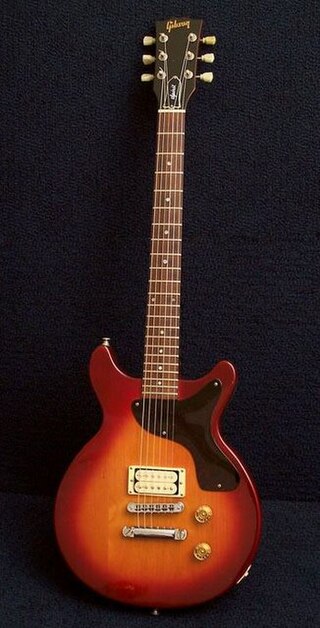
The Gibson Spirit was a guitar model sold under Gibson and Epiphone USA nameplates in the 1980s. This article does not refer to the made-in-China Spirit guitar sold under the Gibson Baldwin Music Education nameplate.
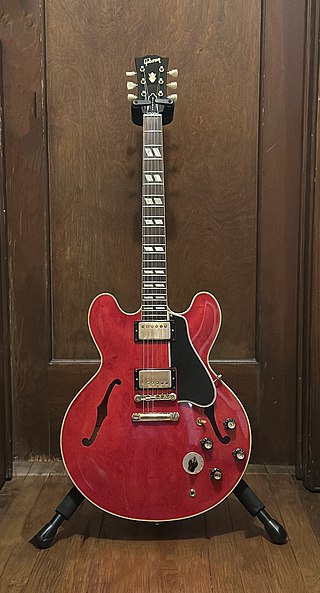
The Gibson ES-345 is a guitar manufactured by the Gibson Guitar Company. The guitar was produced from 1959 to 1981. It was designed as a jazz guitar and an upscale version of the ES-335.

The Gibson ES-165 Herb Ellis is an Archtop guitar manufactured by the Gibson Guitar Corporation in Nashville Tennessee. By March 2013, it was no longer in production.
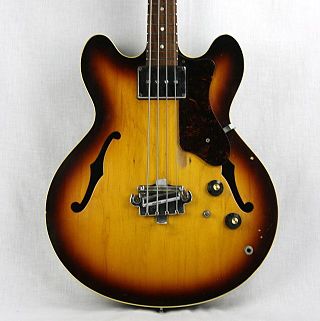
The Epiphone Rivoli was a semi-hollowbody electric bass guitar designed by Gibson and built by Epiphone in Kalamazoo, Michigan from 1959 until 1970. From 1993 until 1999, the model was reissued as a part of the Korean-Japanese Epiphone line.




















